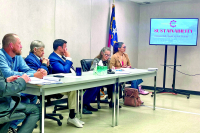A briefcase of possibilities
 I grade about 2,000 essays a year. I do so because I am a high school English teacher, and because I also score Advanced Placement essays for a week every summer for Educational Testing Service. The first year I worked for ETS, by the second day of scoring, I had blurred vision, a stiff neck, and a dread of reading the words “relatable” or “cliché” one more time in the student responses to the essay portion of the test. But something happened the third day, the same something that happens when I read my own students’ work. Call it renewed vision. Call it human connection. Or call it fatigue hallucination. Whatever you call it, I began to read the essays as if they spoke directly to me, and what they said was that adolescents are as hungry for decency, hope, and goodness as any generation before them.
I grade about 2,000 essays a year. I do so because I am a high school English teacher, and because I also score Advanced Placement essays for a week every summer for Educational Testing Service. The first year I worked for ETS, by the second day of scoring, I had blurred vision, a stiff neck, and a dread of reading the words “relatable” or “cliché” one more time in the student responses to the essay portion of the test. But something happened the third day, the same something that happens when I read my own students’ work. Call it renewed vision. Call it human connection. Or call it fatigue hallucination. Whatever you call it, I began to read the essays as if they spoke directly to me, and what they said was that adolescents are as hungry for decency, hope, and goodness as any generation before them.
Not unlike social workers and nurses, public school teachers have a forced awareness of the lives of the poor, and we deal daily with behaviorally challenged youth struggling to understand societal expectations. Therefore, we could, if we let ourselves, become cynics about our charges. Again and again, from A Nation at Risk, to Reviving Ophelia, to The World Is Flat and Generation iY, we are warned by the knowing that we must do something about young people or we are going to lose them to whatever cultural affliction is most current. While these publications have helped us better understand the messages America sends its children, as teachers, we must read the research, hold it up against the light of what our students are saying, and between the two of these find the best-illuminated path in doing our work with the young.
So when I begin to heed too much the world’s view of my students, that they are superficial, or violent, or discourteous, I go to a wall in my classroom where I post selections from their writing. I return to that place of vision, of connection, of human potential, as when one student, responding to George Eliot on realistic art, wrote, “Art must teach compassion by representing people as we really are.” Another, responding to George Bernard Shaw on his mother’s cremation, said, “The happiness we gain from relationships doesn’t end with death.” Yet another, when writing an essay on Toni Morrison’s Beloved, wrote, “The ghost of slavery haunts America to this day.” And when they wrote about a pivotal day in their lives, even though so many wrote about their fathers leaving, never to return, their papers ended almost uniformly with the desire for reconciliation, if only he would call.
I suppose that’s why, even when the briefcase I carry is heavy with stacks of essays, the weight of it is not a burden. Teaching other people’s children remains for me a privilege, and seeing their possibilities, the possibilities that others might miss, is the wondrous reward of my profession.
(Dawn Gilchrist is a writer and a high school English teacher in Swain County. She can be reached at This email address is being protected from spambots. You need JavaScript enabled to view it..)









